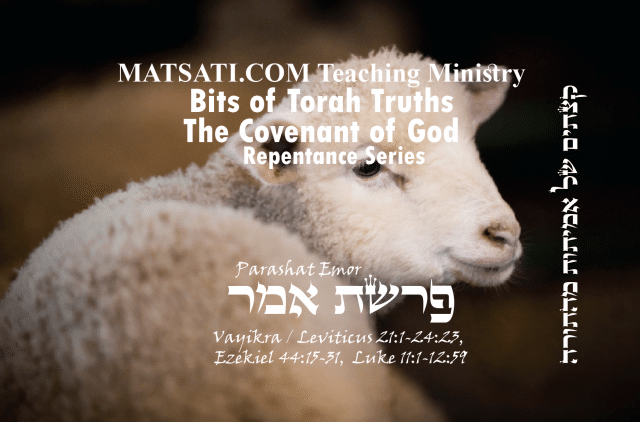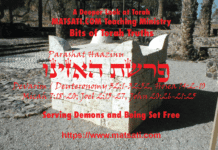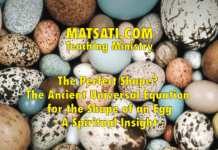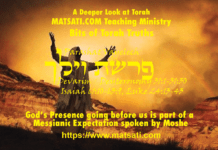In the Apostolic Writings (NT), in the books of John and Revelation we see the phrase “Lamb of God” being used frequently as a reference to the Messiah. Have ever wondered where the phrase “Lamb of God” originates, how, and why this phrase was applied to Yeshua the Messiah? I would like to discuss this topic in this weeks study. In Parashat Emor, Moshe tells us, כט וְכִי-תִזְבְּחוּ זֶבַח-תּוֹדָה לַיהוָֹה לִרְצֹנְכֶם תִּזְבָּחוּ: 22:29 ‘When you sacrifice a sacrifice of thanksgiving to the Lord, you shall sacrifice it so that you may be accepted. (NASB) The Scriptures this week speak of the commands being performed in the way the Lord wants them to be performed. This is very important as it is related to our redemption and atonement. For example, the daily offering of the Olat Tamid (עלת תמיד), the continual raise offering, consisted of 2 parts, one lamb was offered at the start of the daily service (soon after daybreak), the second lamb was brought in the afternoon (towards evening), at the end of the service (see Bamidbar/Numbers 28:4 ד אֶת-הַכֶּבֶשֹ אֶחָד תַּעֲשֶֹה בַבֹּקֶר וְאֵת הַכֶּבֶשֹ הַשֵּׁנִי תַּעֲשֶֹה בֵּין הָעַרְבָּיִם: 28:24 ‘You shall offer the one lamb in the morning and the other lamb you shall offer at twilight; NASB). It is from the Olat Tamid that we derive the significance of the phrase “the Lamb of God” in the sense that it is the lamb which opens and closes the daily sacrificial services. It is also the Tamid offering that signals the beginning and end of the Jewish day. The lamb of God signifies the absolute subjugation of the Jewish life to God and marked the beginning of man’s daily journey to walk in godliness. It is also interesting to note that the Tamid parallels the Shema which is itself recited twice daily, in the beginning of the day and once again in the evening, with draws one to the daily affirmation of God’s heavenly and earthly kingship. The context of the Shema draws one to believe in the oneness of God and to hold onto the Lord, to love the Lord with all one’s heart and soul. The Word of God is to become a part of our lives that is said to be “upon our hearts,” we are to diligently teach God’s word to our children, speaking of God’s word always when raising up and when laying down, and God’s Word is to become a part of our homes, to the very foundation of who we are, as the Scriptures say, God’s word is written upon the doors of our homes and are to be placed upon our foreheads and as a sign on our hands. These things describe the position of the Word of God in our lives as going before us, directing our minds (forehead), and being at our right hand, a position of power and authority in our lives for discerning between what is right as opposed to what is wrong. We find the Shema defining the beginning and the ending of the day for the believer in the kingdom of God. Within the confines of the Lamb of God we also find the definition of the two ends of the day for the sacrificial service, we are reminded of the presence of God in our lives which is paralleled to the first and last raise offering (Olat Tamid), reminding man to daily seek the Lord God of Israel. These are the core principles of living a biblical life, one that is marked by a consistent spiritual growth with a focus upon the Lord in heaven that is centered upon the Lamb of God from a first century context. The lamb of God being offered during the Tamid, directed the worshiper to understand the entire spiritual service in the temple is contained within the blood of the Lamb which encompasses our entire spiritual life before the Lord as it pertains to sin, atonement, and redemption. This may be why John HaMatbil (יוחנן המטביל, John the baptizer) said what he did in regards to Yeshua saying, John 1:29 The next day he saw Jesus coming to him and said, ‘Behold, the Lamb of God who takes away the sin of the world!’ (NASB) Taking these things into consideration, it is possible to understand how the Messiah, as taught by the Apostolic Writings, has led to the belief that the existence of God’s people is established in the Messiah who is called “the Lamb of God.” Yeshua taught if we abide in him and his word abides in us (John 15:7) whatever we ask for, it will come to pass. Within the context of the Olat Tamid, this is a very powerful statement because within the Lamb defined by the Olat Tamid is contained all of what God wants for our lives. Let’s discuss these things further in this week’s Torah study.
This week we are looking at Vayikra / Leviticus 22:29-23:4.
Vayikra / Leviticus 22:29-23:4
22:29 ‘When you sacrifice a sacrifice of thanksgiving to the Lord, you shall sacrifice it so that you may be accepted. 22:30 ‘It shall be eaten on the same day, you shall leave none of it until morning; I am the Lord. 22:31 ‘So you shall keep My commandments, and do them; I am the Lord. 22:32 ‘You shall not profane My holy name, but I will be sanctified among the sons of Israel; I am the Lord who sanctifies you, 22:33 who brought you out from the land of Egypt, to be your God; I am the Lord.’ 23:1 The Lord spoke again to Moses, saying, 23:2 ‘Speak to the sons of Israel and say to them, ‘The Lord’s appointed times which you shall proclaim as holy convocations My appointed times are these: 23:3 ‘For six days work may be done, but on the seventh day there is a sabbath of complete rest, a holy convocation. You shall not do any work; it is a sabbath to the Lord in all your dwellings. 23:4 ‘These are the appointed times of the Lord, holy convocations which you shall proclaim at the times appointed for them. (NASB)כט וְכִי-תִזְבְּחוּ זֶבַח-תּוֹדָה לַיהוָֹה לִרְצֹנְכֶם תִּזְבָּחוּ: ל בַּיּוֹם הַהוּא יֵאָכֵל לֹא-תוֹתִירוּ מִמֶּנּוּ עַד-בֹּקֶר אֲנִי יְהוָֹה: לא וּשְׁמַרְתֶּם מִצְוֹתַי וַעֲשִֹיתֶם אֹתָם אֲנִי יְהוָֹה: לב וְלֹא תְחַלְּלוּ אֶת-שֵׁם קָדְשִׁי וְנִקְדַּשְׁתִּי בְּתוֹךְ בְּנֵי יִשְֹרָאֵל אֲנִי יְהוָֹה מְקַדִּשְׁכֶם: לג הַמּוֹצִיא אֶתְכֶם מֵאֶרֶץ מִצְרַיִם לִהְיוֹת לָכֶם לֵאלֹהִים אֲנִי יְהוָֹה: [רביעי] א וַיְדַבֵּר יְהוָֹה אֶל-מֹשֶׁה לֵּאמֹר: ב דַּבֵּר אֶל-בְּנֵי יִשְֹרָאֵל וְאָמַרְתָּ אֲלֵהֶם מוֹעֲדֵי יְהֹוָה אֲשֶׁר-תִּקְרְאוּ אֹתָם מִקְרָאֵי קֹדֶשׁ אֵלֶּה הֵם מוֹעֲדָי: ג שֵׁשֶׁת יָמִים תֵּעָשֶֹה מְלָאכָה וּבַיּוֹם הַשְּׁבִיעִי שַׁבַּת שַׁבָּתוֹן מִקְרָא-קֹדֶשׁ כָּל-מְלָאכָה לֹא תַעֲשֹוּ שַׁבָּת הִוא לַיהֹוָה בְּכֹל מוֹשְׁבֹתֵיכֶם: ד אֵלֶּה מוֹעֲדֵי יְהֹוָה מִקְרָאֵי קֹדֶשׁ אֲשֶׁר-תִּקְרְאוּ אֹתָם בְּמוֹעֲדָם:
In this week’s Torah Portion Moshe tels us, כט וְכִי-תִזְבְּחוּ זֶבַח-תּוֹדָה לַיהוָֹה לִרְצֹנְכֶם תִּזְבָּחוּ: 22:29 ‘When you sacrifice a sacrifice of thanksgiving to the Lord, you shall sacrifice it so that you may be accepted. (NASB) This passage leads us to understand that there is more to the sacrifice than simply the slaughter of the animal and the spreading of the blood. The schedule for the Olat Tamid is as follows:
|
SCHEDULE OF THE TAMID SACRIFICE |
|
| Jewish Time | Gregorian Time |
| First Hour | Dawn |
| The first lamb is brought out and tied to the altar at dawn (Mishnah Tamid 3:2-3:3) | The priest prepare the altar
(Shemot / Exodus 29:38-42, Vayikra / Leviticus 6:1-6, Mishnah Tamid 1:2) |
| Third Hour | 9:00 AM |
| The first lamb is sacrificed at 9:00 AM (Mishnah, Tamid 3:7) | 9:00 AM is the first hour of prayer (Shema and Mode Ani) (Acts 2:15) Temple gates open “Shacharit” (morning service) |
| Sixth Hour | Noon |
| The second lamb is brought out and tied to the altar at noon (Mishnah: Tamid 4:1) | Noon is the second hour of prayer (Acts 3:1; 10:9) “Minchah” (gift offering) |
| Ninth Hour | 3:00 PM |
| The second lamb is sacrificed at 3:00 PM (Antiquities of the Jews 14.4.3 (14:65), Philo Special Laws I, XXXV (169)) | 3:00 PM is the third hour of prayer; also called the hour of confession (Acts 3:1, 10:9) “Ma’ariv” (evening: our afternoon is the Jewish evening next day began at sundown) (3 hours of prayer see Mishnah Berakhot) |
At dawn the lamb is brought to the altar which reminds us to begin our day thinking about the things of God. The Lord desires for us to have the correct repentant attitude and to perform the commands in the way that He has designed. This is for the purpose of bringing glory to His name according to His Word and signifies the absolute subjugation of one’s life to God. This is the imagery we receive within the context of the Temple service and the Lamb of God. The sacrificial service is defined in such a way as to remind us of the presence of God in our lives which is paralleled to the first and last raise offering (the Tamid) and how we are to daily seek the Lord God of Israel. Note again how this is designed to lead one to grow spiritually with a focus upon the Lord in heaven that is centered upon the Lamb of God from a first century context. The lamb of God being offered during the Tamid, directed the worshiper to understand the entire spiritual service in the temple is contained within the blood of the Lamb as it pertains to sin and atonement.
The Mishnah Tamid describes the order of starting the daily sacrifice in the Tabernacle and the Temple in Jerusalem in the following way.
Mishnah Tamid 3:2
אמר להם הממונה צאו וראו אם הגיע זמן השחיטה. אם הגיע הרואה אומר ברקאי. מתיא בן שמואל אומר האיר פני כל המזרח עד שהוא בחברון והוא אומר הין: The appointed [priest] said to them: Go out and see if the time of slaughtering [the Tamid] has arrived. If it [the time] has arrived, the watchman would say, “It [the eastern sky] is shining [it is dawn].” Masya ben Shmuel says: [the priest would then ask] “Has the eastern sky lit up until Chevron?” and he [the watchman] would say “Yes!”Mishnah Tamid 3:3
אמר להם צאו והביאו טלה מלשכת הטלאים. והרי לשכת הטלאים היתה במקצוע צפונית מערבית וארבע לשכות היו שם. אחת לשכת הטלאים. ואחת לשכת החותמות ואחת לשכת בית המוקד. ואחת לשכת שהיו עושין בה לחם הפנים. He [The appointed priest] said to them: Go out and bring a lamb from the Chamber of Lambs. Now, the Chamber of Lambs was in the north-western corner [of the Chamber of Fire]. There were four chambers there: one was the chamber of lambs, one was the Chamber of Seals, [where one could buy tokens marked with the appropriate meal offering], one was the Chamber of Fire, and one was the chamber where they would make the Lechem HaPanim.
The Mishnah provides details on how the priest determined whether the time to slaughter the Tamid has arrived which is established by the position of the sun in the sky. This is important because the sun light defines the day for the Jewish community. Our day is to begin thinking upon the Lamb of God. If it was the correct time, the lamb would be brought in from the Chamber of Lambs. The Mishnah describes three chambers, the Chamber of Lambs, the Chamber of Fire, and the Chamber where the Bread of the presence (Lechem HaPanim) was prepared. This indicates that everything was ordered and in its place in preparation for the daily service.
Another commentary Sifrei Bamidbar 143:3 has the following to say concerning the verses we are looking at this week and the Olat Tamid.
Sifrei Bamidbar 143:3
(Bamidbar 28:8) “And the second lamb”: Why is this written? Since it is written “the one lamb shall you offer in the morning,” I might think that if it were not offered in the morning it could be offered in the evening. It is, therefore, written “the second shall you offer up towards evening,” implying that if the morning tamid had not been offered, the evening tamid is not to be offered.• • •
Because it is written (of the Paschal lamb, Shemot 12:6) “and they shall slaughter it at twilight,” I do not know which takes precedence, the tamid or the Paschal lamb. It is, therefore, written “the second” — the second to the tamid, and not second to the Pesach (i.e., it is slaughtered before the Pesach.) From here they ruled: Nothing precedes the morning tamid but (the smoking of) the frankincense. And nothing follows the tamid of twilight but the incense, the Pesach, and those lacking atonement on Pesach eve, so that they can bring their atonement (and observe the Pesach.) (Bamidbar 28:8) “As the meal-offering of the morning and its libation shall you offer it.” What is the intent of this? Because it is written (Ibid. 4-5) “the one lamb shall you offer in the morning and the second lamb shall you offer towards evening.
• • •
And just as “a sweet savor” is written in respect to an ox, so is it written in respect to a lamb and in respect to a bird — whereby the Torah teaches us that there is no “eating” or “drinking” before the Holy One Blessed be He, but (that His) only (“gratification”) is that He speaks and His will is done. And thus is it written (Psalms 50:12) “Were I hungry, I would not tell you. For Mine is the world and its fullness. (11) I know every bird in the mountains, and the creatures of the field are with Me.” Lest I think He eats and drinks, it is written (Ibid. 13) “Do I eat the flesh of bulls or drink the blood of he-goats?” Why, then, do I ask you to sacrifice to Me? To do My will. And thus is it written (Vayikra 22:29) “When you sacrifice a thank-offering to the L-rd, it is to your favor that you sacrifice it.”
The Sifrei Bamidbar commentary speaks of the first and the second lamb which is to be offered at the beginning and the end of the day. The discussion goes that if the first Tamid was not offered, then the second Tamid is not to be offered. The Tamid offering sanctifies the altar for the start of the daily sacrifices. Without the lamb of God to sanctify the altar, no sacrifices would be performed upon the altar based upon the Torah. Note how the rabbis speak of the Pascal lamb (Passover lamb) in relation to the Tamid. Their conclusion is that the Pascal lamb must be brought before the second Tamid or else it must be brought on the next morning. Based upon the rabbis, the Olat Tamid also supercedes the Passover lamb. The point of these sacrifices is “to do the will of God” where the thank offering being spoken of in this week’s Torah portion is done for our favor or enjoyment meaning that we rejoice before the Lord because of His goodness and mercy.
The commentary Sefer HaChinukh 296:1 speaks of sanctifying the name of God as it is related to the sacrifices.
Sefer HaChinukh 296:1
The command to sanctify the Name – We are commanded to sanctify the Name as it is written, “And I will be sanctified in the midst of the Children of Israel” (Leviticus 22:32). This means that one must surrender his life to preserve the religion. TOBM have already explained based on tradition and textual exegesis when this applies. Even though the Torah says, “and you shall live by them” which implies that you should not die for them, they have already received that this is not universally applicable. Through the tradition we live for all matters in the Torah. They explicitly said (Talmud Sanhedrin 74a) that three mitzvot always require martyrdom, and these include idolatry and any of it’s subcategories. This means anything that is prohibited on the strength of it’s unique restrictions, as we will soon explain. Also, sexual impropriety and subcategories, as well as murder. Is a person demands that he worship idols or be killed, he should be killed and not worship, even though his heart will remain true and faithful to HaShem. He still must die and not commit this evil act and allow the assailant to believe that he has denied HaShem. The Sifra says (Sifra Emor 8:6), “For this reason I took you out of Egypt, so that you will publicly sanctify My name.” The same is true for the other two – he must die and not transgress.
The Torah speaks of the Lord dwelling in the midst of His people and that the people are commanded to sanctify the Name of the Lord in their midst. The idea of sanctifying the Name of God is paralleled to one surrendering one’s life to the Lord. Note how the Rabbis say that surrendering one’s life is synonymous to preserving the religion of Judaism. The commentary continues in the discussion on sanctifying the Name, three things require martyrdom (i) idolatry, (ii) sexual immorality, and (iii) and murder. The rabbis say we are to lay down our lives if asked to compromise one of these three things. It is interesting while watching the television these are the three things that we see. Immorality, idolatry in the form of witchcraft, and murder. Is it surprising the evil one has designed what we see on television in these three categories? It is very important not to compromise our faith, and we are called to sanctify the Name of the Lord in our hearts and our lives. The First Century context helps us to understand the importance of starting each day thinking upon the things of God which begins with the Lamb of God.
The sacrificial service of the Olat Tamid (the Lamb of God) was meant to sanctify the altar for the purpose of beginning the daily sacrifices, Olah Korban, Khatat Korban, Asham Korban, and the Shelamim Korban. This was performed for the purpose of sanctifying the Name of God and His word. Based upon what we read of the Messiah, the Name of God is also sanctified in the descriptions of the Messiah as the Lamb of God. In these descriptions, our Father is glorified in the Lamb of God, in His Messiah, and may be the reason for John’s gospel and the book of Revelation using this terminology in reference to the Messiah based upon this First Century context. (John 1:29 The next day he saw Jesus coming to him and said, ‘Behold, the Lamb of God who takes away the sin of the world!’ NASB) Taking these things into consideration, it is possible to understand the teachings of the Disciples on the Messiah as the Lamb of God,which has led to the belief that the existence of God’s people is established in the Messiah who is called “the Lamb of God.” Note how the entirety of the Temple ritual is contained within the sacrifice of the Lamb of God. In the book of Revelation, we read of the Lamb raising up to deliver His people in victory after having been slain. In Paul’s writings, 1 Corinthians 5:7 suggests that the death of Yeshua is paralleled to the Paschal Lamb (Passover lamb), taken from the references from the book of John. The Lamb of God metaphor is also in line with Tehillim / Psalm 23, which depicts the Lord God of Israel as a shepherd leading his flock. The Book of Revelation includes over twenty-nine references to a lion-like lamb (“slain but standing”) which delivers victory. The connection to Yeshua and the Lamb of God is found in Revelation 21:14 where the lamb is said to have twelve apostles. The risen Lamb implies victory for God’s people within the context of the Lamb from both the Olat Tamid and Passover. This Lamb of God gained victory over death and received everlasting life. This Lamb of God who lives forever has the power to also give everlasting life to those who ask. This follows through from the rabbinic concept of sanctifying the Name within the heart of the faithful, remaining true to God’s Word and seeking the Lord each day. These things provide us reason for remaining faithful and true to Yeshua of whom the Scriptures call God’s Messiah, His precious Lamb who sets us free.









